

Learning Strategies. Learning strategies refer to methods that students use to learn.
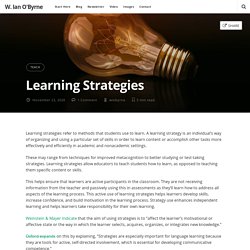
A learning strategy is an individual’s way of organizing and using a particular set of skills in order to learn content or accomplish other tasks more effectively and efficiently in academic and nonacademic settings. These may range from techniques for improved metacognition to better studying or test-taking strategies. Learning strategies allow educators to teach students how to learn, as opposed to teaching them specific content or skills. This helps ensure that learners are active participants in the classroom. 10 Metacognitive Prompts To Help Students Reflect On Their Learning -
By TeachThought Staff & Peter Pappas It’s well-established that reflection is critical in the learning process.
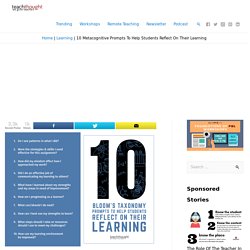
While it sounds formal, ‘reflection’ simply means to ‘think again’ about something that happened. Four Research-Based Strategies To Ignite Intrinsic Motivation In Students. What Teachers Need To Know About The Science Of Learning. Lately there’s been a push to acquaint educators with “the science of learning.”
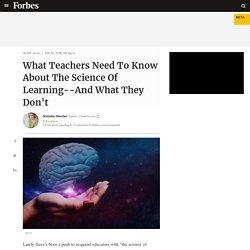
But only some aspects of that science actually help teachers do their jobs. Others just waste their time. You might think that before aspiring teachers take up their posts, they’re taught what scientists have discovered about how children learn. Multiple Intelligences Theory: Widely Used, Yet Misunderstood. When Howard Gardner introduced his multiple intelligences theory 35 years ago, it was a revolutionary idea that challenged long-cherished beliefs.
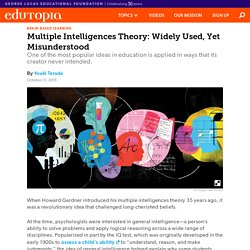
At the time, psychologists were interested in general intelligence—a person’s ability to solve problems and apply logical reasoning across a wide range of disciplines. Popularized in part by the IQ test, which was originally developed in the early 1900s to assess a child’s ability to “understand, reason, and make judgments,” the idea of general intelligence helped explain why some students seemed to excel at many subjects. Gardner found the concept too limiting. “Most lay and scholarly writings about intelligence focus on a combination of linguistic and logical intelligences. The particular intellectual strengths, I often maintain, of a law professor,” Gardner explains. That doubt planted the seed that grew into Gardner’s big insight: The prevailing idea of a single, monolithic intelligence didn’t match the world he observed.
Wide Acceptance. Neuroteach Global Research Base - Neuroteach Global. Why Reading Books Should Be Your Priority, According to Science. Innovation Playlist - Ted Dintersmith. Face it.

Like all organizations, schools get locked into routine, impeding change. But all schools need to innovate to prepare kids for a dynamic and uncertain future. The question is, “How?” The Innovation Playlist can help your school make positive, informed change. It represents a teacher-led model, based on small steps leading to big change, that draws on best practices from outstanding educators and non-profits from across the country.
The Innovation Playlist consists of albums (the big goals on the left) and tracks (the small steps on the right that help you reach each big goal). The “Mobilize Your Community” album is the ideal place to start, letting you generate enthusiasm for innovation. Why Students Forget—and What You Can Do About It. Teachers have long known that rote memorization can lead to a superficial grasp of material that is quickly forgotten. But new research in the field of neuroscience is starting to shed light on the ways that brains are wired to forget—highlighting the importance of strategies to retain knowledge and make learning stick. In a recent article published in the journal Neuron, neurobiologists Blake Richards and Paul Frankland challenge the predominant view of memory, which holds that forgetting is a process of loss—the gradual washing away of critical information despite our best efforts to retain it.
According to Richards and Frankland, the goal of memory is not just to store information accurately but to “optimize decision-making” in chaotic, quickly changing environments. In this model of cognition, forgetting is an evolutionary strategy, a purposeful process that runs in the background of memory, evaluating and discarding information that doesn’t promote the survival of the species. Why Students Forget—and What You Can Do About It. Coaching Classroom Instruction, Tips. Coaching Classroom Instruction Trust among coaches and teachers greatly increases teachers’ willingness to make changes in their instructional habits or behaviors.
Many teachers care deeply about their profession, their courses’ subject matter, and the students they teach, which can make them feel vulnerable in coaching situations. Curriculum Update:Instruction:Getting Acquainted with the Essential Nine. Do schools affect girls’ and boys’ reading performance differently? A multilevel study on the gendered effects of school resources and school practices: School Effectiveness and School Improvement: Vol 0, No 0. Introduction In the current study, we sought to better understand the established female advantage in education by investigating for a wide range of countries whether various school characteristics affected the reading performance of girls and boys differently.
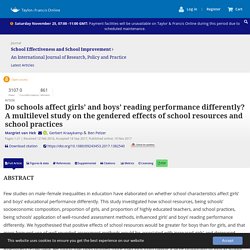
We focused on students’ reading performance for two reasons. First, reading comprehends a core competency in a person’s educational career (Organisation for Economic Co-operation and Development [OECD], 2010 Organisation for Economic Co-operation and Development. (2010). Pathways to success – How knowledge and skills at age 15 shape future lives in Canada. Paris, France: Author. Pedagogies of Dissent. #NewEducation Overview: This post combines two blog posts on engaged pedagogy originally published on hastac.org in June 2015 and October 2017.

The first post offers classic rationales for what is called “active learning” or engaged, student-centered, or radical pedagogy. It then offers several specific methods, with details for how to make these work in your classroom, meetings, or social organizing. Are these the 7 pillars of classroom practice? There are two main problems with the idea that teachers should be reading research.
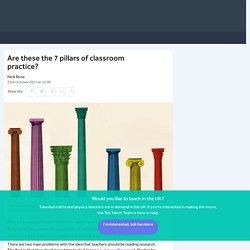
The first is that they don’t have time to do it (see bit.ly/UnreadResearch). Studies by the Education Endowment Foundation (EEF) have examined methods of encouraging teachers to engage with academic research but report that time pressures – and a lack of opportunities for teachers to work together – appear to undermine the initiatives. So, if we genuinely want teaching to be a research-informed profession, we should reduce the number of hours we expect teachers to work – and ultimately set aside some time for teachers to read and apply research to their practice.
The second problem is actually finding research related to the questions we have as teachers. Are these the 7 pillars of classroom practice? Energy and Calm: Brain Breaks and Focused-Attention Practices. When presented with new material, standards, and complicated topics, we need to be focused and calm as we approach our assignments.
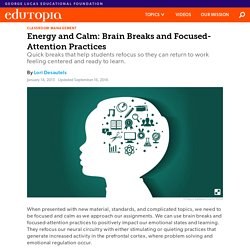
We can use brain breaks and focused-attention practices to positively impact our emotional states and learning. They refocus our neural circuitry with either stimulating or quieting practices that generate increased activity in the prefrontal cortex, where problem solving and emotional regulation occur. Brain Breaks A brain break is a short period of time when we change up the dull routine of incoming information that arrives via predictable, tedious, well-worn roadways. Our brains are wired for novelty. When we take a brain break, it refreshes our thinking and helps us discover another solution to a problem or see a situation through a different lens. The Junk Bag: I always carry a bag of household objects containing markers, scrap paper, and anything that one would find in a junk drawer—for example, a can opener or a pair of shoelaces.
ELINET. The Big List of Class Discussion Strategies. Reading the reader: A survey of Australian reading habits – Australia Council. SAGE Journals: Your gateway to world-class journal research. Teenagers can become disruptive if teachers use psychological pressure - UKEdChat.com. 8 Myths That Undermine Educational Effectiveness.
Certain widely-shared myths and lies about education are destructive for all of us as educators, and destructive for our educational institutions.
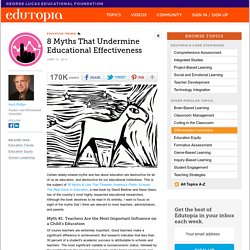
This is the subject of 50 Myths & Lies That Threaten America’s Public Schools: The Real Crisis in Education, a new book by David Berliner and Gene Glass, two of the country’s most highly respected educational researchers. Although the book deserves to be read in its entirety, I want to focus on eight of the myths that I think are relevant to most teachers, administrators, and parents. Myth #1: Teachers Are the Most Important Influence on a Child’s Education Of course teachers are extremely important. Good teachers make a significant difference in achievement. Myth #2: Homework Boosts Achievement There is no evidence that this is true. Myth #3: Class Size Does Not Matter In an average high school, one teacher is responsible for 100-150 students on any given day.
12 Principles Of Modern Learning. 12 Principles Of Modern Learning by TeachThought Staff. The Tyranny of Being On Task. I remember when I was first teaching and was getting ready for my first official observation and evaluation. I was very nervous. My principal had told me she would be looking for a classroom where students were on task. Heaven forbid that any students were off task. I thought that if my classroom even hinted that some students were off task, I would never be a successful teacher, and perhaps told to leave the teaching profession. Building Language and Literacy Skills - Taking Center Stage-Act II (TCSII) (CA Dept of Education)
In this Professional Learning Activity, Dr. Kinsella explores steps in effectively setting up discussion tasks for students. Take Stock: pre-video reflection exercise Take Time: watch the video Take Action: initial activities designed to help educators implement the practices suggested Take it Away: answer questions designed to help educators identify support and resources needed to implement the suggested practices This professional learning activity is one of several in the TCSII Get into the Act! Professional Learning Series. Dr. Teaching English. Educational Leadership:Teaching for the 21st Century:Six Steps to Better Vocabulary Instruction. Teaching Vocabulary in the Middle Grades - Taking Center Stage-Act II (TCSII) (CA Dept of Education)
In this Professional Learning Activity, Dr. Edutopia. Education Research Highlights From 2016. In 2016, we learned more about how teachers feel about their profession, from the reasons why they started teaching in the first place (#1) to why they leave (#6). Do2Learn: Educational Resources for Special Needs. The TL Toolkit for Student Success Home.